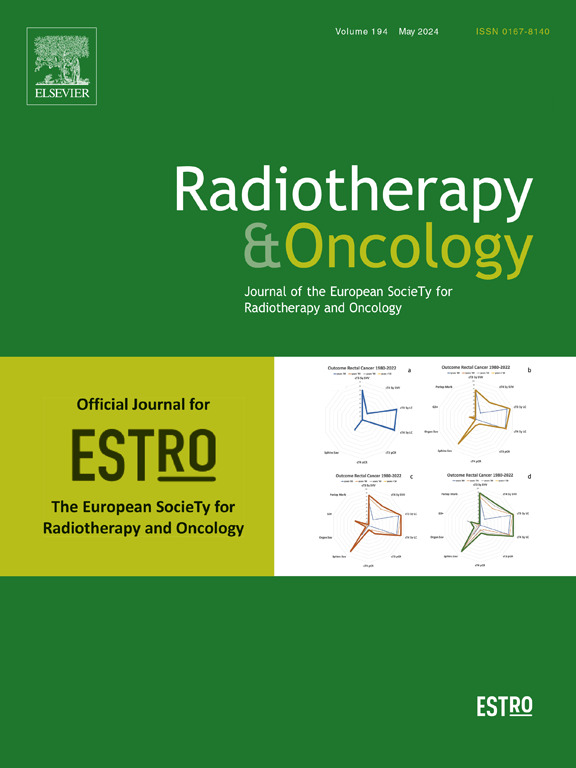Development and validation of Prediction models for radiation-induced hypoglossal neuropathy in patients with nasopharyngeal carcinoma
IF 4.9
1区 医学
Q1 ONCOLOGY
引用次数: 0
Abstract
Background and purpose
To establish predictive models for radiation-induced hypoglossal neuropathy (RIHN) in patients with nasopharyngeal carcinoma (NPC) after intensity-modulated radiotherapy (IMRT).
Materials and methods
Data from 423 NPC patients receiving IMRT-based treatment were retrospectively reviewed. They were randomly (3:2) divided into a training set (n = 256) and a testing set (n = 167). Dosimetric variables were selected by penalized regression and machine learning, with area under the receiver operating curve (AUC) calculated. Clinical variables were selected by the competitive risk analysis. A competitive risk model including clinical and dosimetric variables was performed, and a nomogram was generated as a visualization of the model to predict the incidence of RIHN.
Results
During a median follow-up of 102 months (IQR: 89.5 to 112.9 months), the cumulative incidence of RIHN at 3, 5, and 8 years were 2.1 %, 5.4 %, and 10.5 %, respectively. D1cc and aV75 were the most predictive dosimetric variables. The dose–effect curve plotted with D1cc indicated the tolerance dose for a 5 % probability of developing RIHN in 8 years (TD5/8) was 77.3 Gy (EQD2). The restricted cubic spline between aV75 and RIHN indicated a volume threshold of 0.81 cm3. A competitive risk model including hypoglossal canal involvement, concurrent chemotherapy, D1cc, and aV75 was established, with the C-index of the training set and testing set being 0.726 and 0.691, respectively. The nomogram-defined high-risk group had the higher RIHN incidences in the training and testing sets.
Conclusions
This study identified the most critical dosimetric predictors, which is expected to become a feasible dose constraint for hypoglossal nerves in radiation plan. Combining dosimetric and clinical predictors, we further proposed and validated the first nomogram model to quantify the risk of RIHN, contributing to identifying high-risk patients and early intervention. Further multicenter studies are needed to validate or complement our findings.
鼻咽癌放射性舌下神经病变预测模型的建立与验证
背景与目的建立鼻咽癌(NPC)调强放疗(IMRT)后放射性引起的舌下神经病变(RIHN)的预测模型。材料和方法回顾性分析423例接受imrt治疗的鼻咽癌患者的资料。他们被随机(3:2)分为训练集(n = 256)和测试集(n = 167)。通过惩罚回归和机器学习选择剂量学变量,计算受试者工作曲线下面积(AUC)。通过竞争风险分析选择临床变量。建立了一个包括临床和剂量学变量的竞争风险模型,并生成了一个可视化的模式图来预测RIHN的发病率。结果中位随访102个月(IQR: 89.5 ~ 112.9个月),3年、5年和8年的RIHN累计发病率分别为2.1%、5.4%和10.5%。D1cc和aV75是最具预测性的剂量学变量。用D1cc绘制的剂量效应曲线显示,8年内发生RIHN概率为5%的耐受剂量(TD5/8)为77.3 Gy (EQD2)。aV75和RIHN之间的受限三次样条曲线表明体积阈值为0.81 cm3。建立包括舌下管受累、同期化疗、D1cc、aV75的竞争风险模型,训练集c指数为0.726,测试集c指数为0.691。在训练组和测试组中,nomogram定义的高危组有较高的RIHN发生率。结论本研究确定了最关键的剂量学预测因子,有望成为舌下神经放射计划中可行的剂量限制指标。结合剂量学和临床预测指标,我们进一步提出并验证了首个量化RIHN风险的nomogram模型,有助于识别高危患者和早期干预。需要进一步的多中心研究来验证或补充我们的发现。
本文章由计算机程序翻译,如有差异,请以英文原文为准。
求助全文
约1分钟内获得全文
求助全文
来源期刊

Radiotherapy and Oncology
医学-核医学
CiteScore
10.30
自引率
10.50%
发文量
2445
审稿时长
45 days
期刊介绍:
Radiotherapy and Oncology publishes papers describing original research as well as review articles. It covers areas of interest relating to radiation oncology. This includes: clinical radiotherapy, combined modality treatment, translational studies, epidemiological outcomes, imaging, dosimetry, and radiation therapy planning, experimental work in radiobiology, chemobiology, hyperthermia and tumour biology, as well as data science in radiation oncology and physics aspects relevant to oncology.Papers on more general aspects of interest to the radiation oncologist including chemotherapy, surgery and immunology are also published.
 求助内容:
求助内容: 应助结果提醒方式:
应助结果提醒方式:


